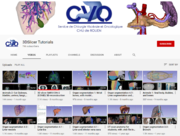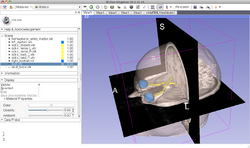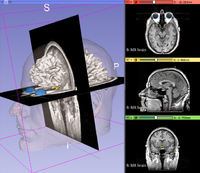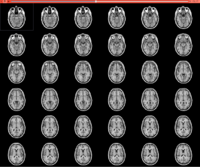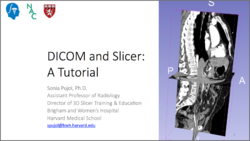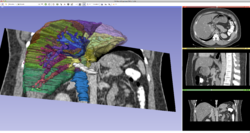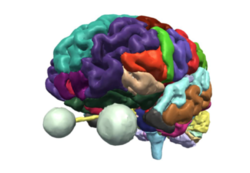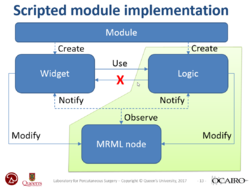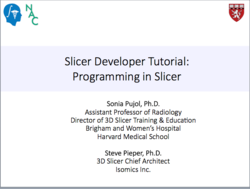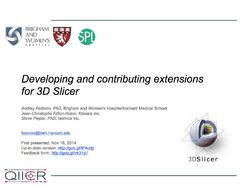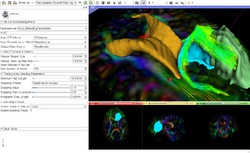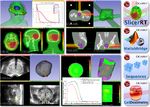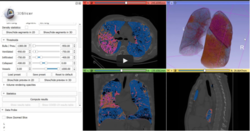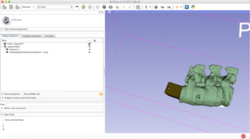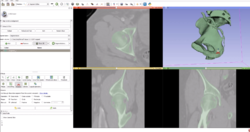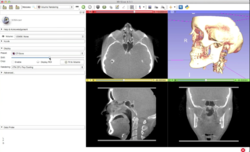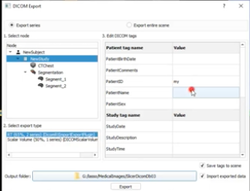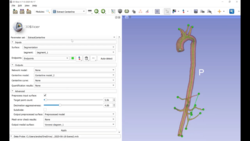Home < Documentation < Nightly < TrainingIntroduction: Slicer Tutorials
- Some of these tutorials are based on older releases of 3D Slicer and are being upgraded to Slicer 5.0. The concepts are still useful but some interface elements and features may be different in updated versions. For tutorials for older versions of Slicer, please visit the Slicer training portal.
Quick Start Guide
Downloading and Installing Slicer
- The Quick Start Guide shows how to install and start 3D Slicer
- Author: Sonia Pujol, Ph.D.
- Based on 3D Slicer 5.0 / 4.11
|
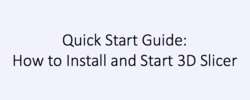
|
General Introduction
Slicer Welcome Tutorial
- The Slicer Welcome tutorial is an introduction to Slicer.
- Author: Sonia Pujol, Ph.D.
- Audience: First-time users who want a general introduction to the software
- Modules: Welcome to Slicer, Sample Data
- Based on 3D Slicer 4.8
- Compatible with Slicer 4.10.1
|
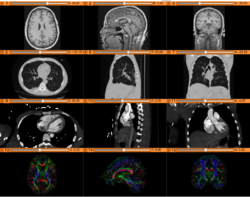
|
Slicer4Minute Tutorial
- The Slicer4 Minute Tutorial is a brief introduction to the advanced 3D visualization capabilities of Slicer.
- Author: Sonia Pujol, Ph.D.
- Audience: First-time users who want to discover Slicer in 4 minutes
- Modules: Welcome to Slicer, Models
- Based on Slicer version 4.8
- Compatible with Slicer 4.10.1
- The Slicer4Minute dataset contains an MR scan of the brain and 3D reconstructions of the anatomy
|
|
3D Visualization
Data Loading and 3D Visualization
|
- Slicer 4.10
- The Data loading and visualization (pptx) course guides through the basics of loading and viewing volumes and 3D models in Slicer 4.10.
- Author: Csaba Pinter
- Modules: Welcome to Slicer, Data, Volume Rendering, Models.
- Audience: End-users
- Based on Slicer 4.9
- Compatible with Slicer 4.10.1
- The 3DVisualization dataset contains an MR scan and a series of 3D models of the brain.
|
|
DICOM
- The DICOM and Slicer tutorial provides an introduction to the DICOM standard and shows how to load and visualize DICOM datasets in 3D Slicer version 5.0.
- Author: Sonia Pujol, Ph.D.
- Modules: DICOM, Volumes
- Based on: 3D Slicer version 5.0/4.11
- The 3D Slicer DICOM Tutorial Data contains a torso-CT and a breast MRI.
|
|
- The 3D Visualization of DICOM images course guides through 3D data loading and visualization of DICOM images for Radiology Applications in Slicer4.
- Author: Sonia Pujol, Ph.D., Kitt Shaffer, M.D., Ph.D., Ron Kikinis, M.D.
- Audience: Radiologists and users of Slicer who need a more comprehensive overview over Slicer4 visualization capabilities.
- Modules: DICOM, Volumes, Volume Rendering, Models.
- Based on: 3D Slicer version 4.8
- Compatible with 3D Slicer version 4.10
- The 3DVisualizationDICOM_part1 and 3DVisualizationDICOM_part2 datasets contain a series of MR and CT scans, and 3D models of the brain, lung and liver.
|
|
Open Anatomy Browser
- The Open Anatomy Browser tutorial is an introduction to the OABrowser technology for viewing and interacting with atlases.
- Author: Sonia Pujol, Ph.D., Mike Halle, Ph.D.
- Audience: End-users
|
Tutorials for software developers
PerkLab's Slicer bootcamp training materials
- The Laboratory for Percutaneous Surgery at Queen's University has made available training material of its internal yearly bootcamp, covering topics, such as 3D Slicer overview, basic visualization, segmentation, registration, scripting and module development, surgical navigation, DICOM, reproducible medical image computing research methodology, version control, and research project management.
- Author: Andras Lasso, Csaba Pinter, Tamas Ungi, Csaba Pinter, Matthew Holden, Kyle Sunderland
- Audience: Developers, Users
- Based on: 3D Slicer version 4.10
|
|
Slicer Programming Tutorial
- The Slicer Programming tutorial guides through the integration of a python module in Slicer. It provides an introduction to the Python Console and the Qt Widget toolkit in 3D Slicer.
- Author: Sonia Pujol, Ph.D., Steve Pieper, Ph.D.
- Audience: Developers
- Based on: 3D Slicer version 5.0/4.11
|
|
Slicer script repository
For additional Python scripts examples, please visit the Script repository.
Developing and contributing extensions for 3D Slicer
Segmentation
- Segmentation for 3D printing: shows how to use the Segment Editor module for combining CAD designed parts with patient-specific models.
|
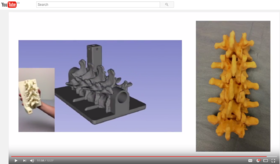
|
- Video tutorial: Whole heart segmentation from cardiac CT shows how to use the Segment Editor module for segmenting heart ventricles, atria, and great vessels from cardiac CT volumes.
- Author: Andras Lasso, PhD
- Audience: Users who need to segment heart structures, for example for visualization, quantification, or simulation.
- Sample data set
- Based on: 3D Slicer version 4.8
|
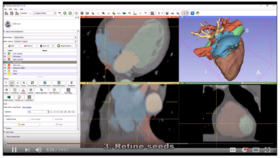
|
|
|
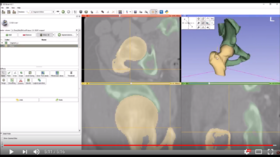
|
- Slicer Segmentation Recipes provide step-by-step description of useful segmentation techniques.
- Segmentation tutorials for common tasks, such as skin surface extraction, craniotomy (splitting segments), sorta segmentation, cerebral vessel segmentation by subtraction, segmentation on arbitrarily oriented slices, skull stripping.
|

|
- The Skull Stripping tutorial shows how to perform skull-stripping in CT and MR data.
- Author: Sonia Pujol, PhD, Andras Lasso, PhD, Ron Kikinis, MD
- Audience: Users interested in brain segmentation
- Based on: 3D Slicer version 4.11
|
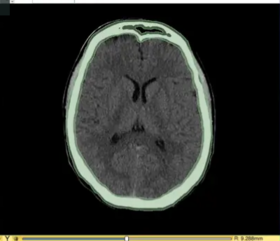
|
Image Phenotyping
- Based on: 3D Slicer version 4.10
- The Image Phenotyping tutorial is an introduction to brain tumor segmentation and image phenotyping using the Slicer Radiomics extension.
- Authors: Sonia Pujol, Ph.D.
- Audience: Clinical researchers
- Dataset: Meningioma dataset
|
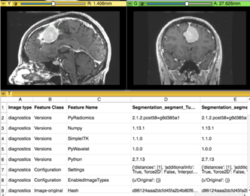
|
Registration
Slicer4 Image Registration
- The Registration tutorial shows how to perform intra- and inter-subject registration within Slicer.
- Authors: Sonia Pujol, Ph.D., Dominik Meier, Ph.D., Ron Kikinis, M.D.
- Audience: Users and developers interested in image registration
- Dataset: 3D Slicer Registration Data
|

|
- Based on: 3D Slicer version 4.8; Compatible with Slicer 4.10
- The Brain Tumor Registration is a video-based tutorial that shows how to register two MRI datasets in a brain tumor case for surgical resection follow-up.
- Authors: Sonia Pujol, Ph.D., Dominik Meier, Ph.D.
- Audience: Users and developers interested in image registration
- Dataset: Registration Library Case #37
|
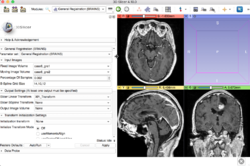
|
- Based on: 3D Slicer version 4.10
Slicer Registration Case Library
- The Slicer Registration Case Library provides real-life example cases of using the Slicer registration tools. They include pre-computed dataset and step-by-step instructions for users to follow.
- Author: Dominik Meier, Ph.D.
- Audience: users interested learning/applying Slicer image registration technology
|
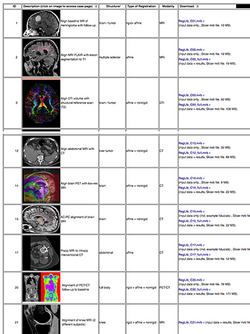
|
Slicer Extensions
Slicer4 Diffusion Tensor Imaging Tutorial
- The Diffusion MRI Tutorial is an introduction to the basics of loading diffusion weighted images in Slicer, estimating tensors and generating fiber tracts.
- Author: Sonia Pujol, Ph.D.
- Audience: End-users and developers
- Modules: Data, Volumes, DWI to DTI Estimation, Diffusion Tensor Scalar Measurements, Editor, Markups, Tractography Label Map Seeding, Tractography Interactive Seeding
- Based on: 3D Slicer version 4.8; Compatible with Slicer version 4.10.2
- The Slicer Diffusion MRI Tutorial dataset contains an MR Diffusion Weighted Imaging scan of the brain.
- Please visit dmri.slicer.org/docs for the latest documentation of SlicerDMRI.
|
|
Slicer4 Neurosurgical Planning Tutorial
- The Neurosurgical Planning tutorial course guides end-users through the generation of fiber tracts in the vicinity of a tumor.
- Author: Sonia Pujol, Ph.D., Ron Kikinis, M.D.
- Audience: Clinicians and Clinical Researchers
- Modules: Segment Editor, Tractography
- Based on 3D Slicer version 4.10
- The White Matter Exploration dataset contains a Diffusion Weighted Imaging scan of a brain tumor patient.
|
|
Slicer4 Quantitative Imaging tutorial
- The Slicer4 Quantitative Imaging tutorial guides through the use for Slicer for quantifying small volumetric changes in slow-growing tumors, and for calculating Standardized Uptake Value (SUV) from PET/CT data.
- Authors: Sonia Pujol, Ph.D., Katarzyna Macura, M.D., Ron Kikinis, M.D.
- Audience: Radiologists and users of Slicer who need a more comprehensive overview over Slicer4 quantitative imaging capabilities.
- Modules: Data, Volumes, Models, Change Tracker, PET Standard Uptake Value Computation
- Based on: 3D Slicer version 4.5
- The Quantitative Imaging dataset contains a series of MR and PET/CT data.
|
|
Slicer4 IGT
- Slicer IGT tutorials
- Authors: Tamas Ungi, M.D, Ph.D., Junichi Tokuda, Ph.D.
- Audience: End-users interested in using Slicer for real-time navigated procedures. E.g. navigated needle insertions or other minimally invasive medical procedures.
- Modules: SlicerIGT Extension
- Based on: Slicer4.3.1-2014.09.14
- Data: Slicer-IGT datasets
|
|
Slicer4 Radiation Therapy Tutorial
- The SlicerRT tutorial is an introduction to the Radiation Therapy functionalities of Slicer.
- Author: Csaba Pinter, Andras Lasso, An Wang, Gregory C. Sharp, David Jaffray, Gabor Fichtinger.
- Dataset: download from MIDAS server
- Based on Slicer 4.7
|
|
Slicer Pathology
- The Slicer Pathology Tutorial describes how to use the corresponding tools for automatic and semi-automatic pathology image segmentation.
- Author: Erich Bremer (Stonybrook), Andriy Fedorov (Brigham and Women’s Hospital)
- Dataset: Available directly with the Slicer Pathology Slicer extension.
|
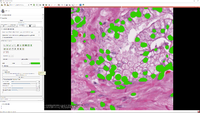 . .
|
SPHARM-PDM
- The SPHARM-PDM Tutorial describes how to use SPHARM-PDM and ShapePopulationViewer Slicer extensions to respectively compute point-based models using a parametric boundary description for the computing of Shape Analysis and perform the quality control between the different models.
- Author: Jonathan Perdomo (UNC), Beatriz Paniagua (Kitware Inc.)
- Dataset: Tutorial Data
|
 . .
|
Fiber Bundle Volume Measurement
- The Fiber Bundle Volume Measurement Tutorial aim is to calculate the volume of the fiber bundle that passes through the Corpus Callosum(CC). Following this tutorial, you’ll be able to (1) convert fiber bundles to label map and (2) calculate volume measurements from the fiber bundles.
- Author: Shun Gong (Shanghai Changzheng Hospital, China)
- Dataset: Tutorial data: The following data are provided: Baseline image, Down sampled whole brain tractography (conducted as in the DWI tutorial and down-sampled to about 10000 fibers using Tractography Display module), Corpus callosum label map (drawn as in the DWI tutorial).
|
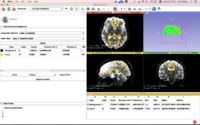 . .
|
Slicer4 Lung CT Analyzer
- The LungCTAnalyzer tutorial and the LungCTAnalyzer video-based demo show how to visualize and quantify infiltration, emphysema and collapsed lung areas in CT datasets acquired on COVID-19 patients.
- Authors: Rudolph Bumm, MD, Andras Lasso, PhD.
- Audience: End-users
- Modules: LungCTSegmenter, LungCTAnalyzer
- Based on: 3D Slicer version 5.0 (4.11)
|
|
3D Slicer version 4.7 Tutorial Contest
For previous editions of the contest, please visit the 3D Slicer Tutorial Contests page
Segmentation for 3D printing
|
|
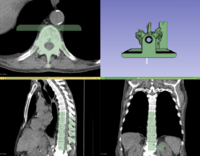 . .
|
Slicer Pathology
- The Slicer Pathology Tutorial describes how to use the corresponding tools for automatic and semi-automatic pathology image segmentation.
- Author: Erich Bremer (Stonybrook), Andriy Fedorov (Brigham and Women’s Hospital)
- Dataset: Available directly with the Slicer Pathology Slicer extension.
|
 . .
|
Simple Python Tool for Quality Control of DWI data
|
|
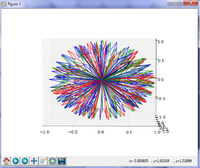 . .
|
SPHARM-PDM
- The SPHARM-PDM Tutorial describes how to use SPHARM-PDM and ShapePopulationViewer Slicer extensions to respectively compute point-based models using a parametric boundary description for the computing of Shape Analysis and perform the quality control between the different models.
- Author: Jonathan Perdomo (UNC), Beatriz Paniagua (Kitware Inc.)
- Dataset: Tutorial Data
|
 . .
|
Integration of Robot Operating System (ROS) and 3D Slicer using OpenIGTLink
|
|
 . .
|
Fiber Bundle Volume Measurement
- The Fiber Bundle Volume Measurement Tutorial aim is to calculate the volume of the fiber bundle that passes through the Corpus Callosum(CC). Following this tutorial, you’ll be able to (1) convert fiber bundles to label map and (2) calculate volume measurements from the fiber bundles.
- Author: Shun Gong (Shanghai Changzheng Hospital, China)
- Dataset: Tutorial data: The following data are provided: Baseline image, Down sampled whole brain tractography (conducted as in the DWI tutorial and down-sampled to about 10000 fibers using Tractography Display module), Corpus callosum label map (drawn as in the DWI tutorial).
|
 . .
|
YouTube videos
Additional non-curated videos-based demonstrations using 3D Slicer are accessible on YouTube.
Teams Contributions
- This Slicer 4.1 webinar presents the new features and improvements of the release, and a brief overview of work for the next release.
- Authors: Steve Pieper Ph.D.
- Audience: First time users and developers interested in Slicer 4.1 new features.
- Length: 0h20m
|
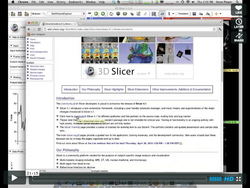
|
- This Intro to Slicer 4.0 webinar provides an introduction to 3DSlicer, and demonstrates core functionalities such as loading, visualizing and saving data. Basic processing tools, including manual registration, manual segmentation and tractography tools are also highlighted. This webinar is a general overview. For in depth information see the modules above and the documentation pages.
- Authors: Julien Finet, M.S., Steve Pieper, Ph.D., Jean-Christophe Fillion-Robin, M.S.
- Audience: First time users interested in a broad overview of Slicer’s features and tools.
- Length: 1h20m
|
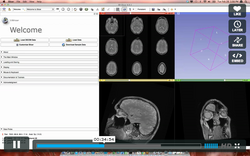
|
International resources
International resources in Chinese and in German are made available by the Slicer community.
Resources in Chinese
|
A 3D Slicer community on WeChat in China offers many tutorials and clinical examples in Chinese. Note that the images are of interest to non-Chinese speakers and Google Translate does a reasonable job of translating some of the text. The tutorials below are examples of Slicer tutorials in Chinese.
The WeChat 3D Slicer Group in China offers a comprehensive list of tutorials in Chinese.
|
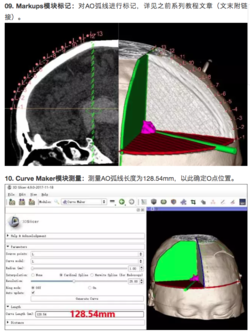
|
Resources in German
Murat Maga's blog posts about using 3D Slicer for biology
Using the (legacy) Editor
Fast GrowCut
- The Fast GrowCut tutorial shows how to perform a segmentation using the Fast GrowCut effect in Slicer.
- Authors: Hillary Lia
- Audience: Users interested in segmentation
|

|
Use case: Slicer in paleontology
This set of tutorials about the use of slicer in paleontology is very well written and provides step-by-step instructions. Even though it covers slicer version 3.4, many of the concepts and techniques have applicability to the new version and to any 3D imaging field:












